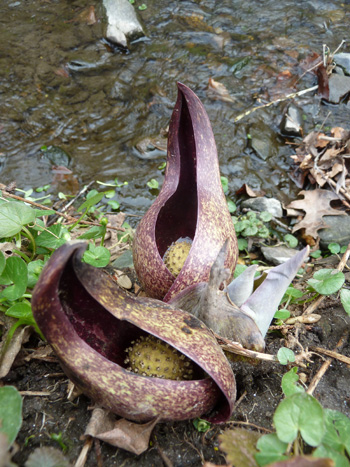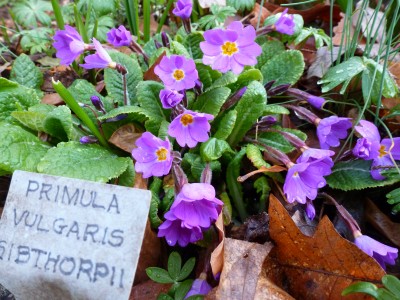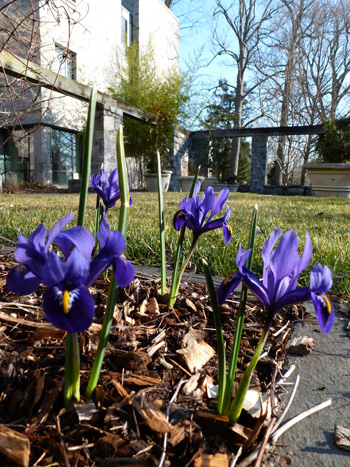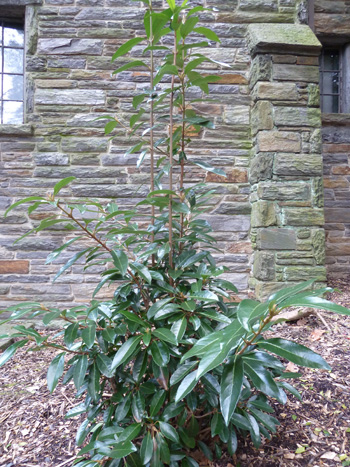Plants of the Week: March 18
 March winds blow a fetid smell through the Crum Woods and surrounding watershed. Such an odor is found throughout the southern and northeastern United States as Symplocarpus foetidus comes into bloom. The arum, commonly known as skunk cabbage, is one of the first marshy woodland bloomers. Plants release heat through a unique cellular process, allowing it to emerge through and melt snow immediately surrounding it. A greenish-yellow spadix, surrounded by a reddish-brown spathe with an opening to the side, emits a skunk-like odor attracting early pollinators. Large leaves emerge after flowering. Photo credit: J. Coceano
March winds blow a fetid smell through the Crum Woods and surrounding watershed. Such an odor is found throughout the southern and northeastern United States as Symplocarpus foetidus comes into bloom. The arum, commonly known as skunk cabbage, is one of the first marshy woodland bloomers. Plants release heat through a unique cellular process, allowing it to emerge through and melt snow immediately surrounding it. A greenish-yellow spadix, surrounded by a reddish-brown spathe with an opening to the side, emits a skunk-like odor attracting early pollinators. Large leaves emerge after flowering. Photo credit: J. Coceano
Location: wet, marshy areas in the Crum Woods
 Primula vulgaris ssp. sibthorpii marked with an original label penned by Mrs. Wister is one of the earliest primroses to bloom. Purplish-pink flowers produced in abundance add a change of color to the multitude of yellow and white geophytes blooming simultaneously. Clumps grow happily in dappled shade with roots anchored in humus-rich soils. Photo credit: J. Coceano
Primula vulgaris ssp. sibthorpii marked with an original label penned by Mrs. Wister is one of the earliest primroses to bloom. Purplish-pink flowers produced in abundance add a change of color to the multitude of yellow and white geophytes blooming simultaneously. Clumps grow happily in dappled shade with roots anchored in humus-rich soils. Photo credit: J. Coceano
Location: Wister Garden
 ‘Pixie’ is noted as one of the richest blue flowering Iris reticulata cultivars. Brent and Becky’s Bulbs of Gloucester, Virginia writes this: “Very small, extremely early flowering, fragrant iris that are perfect for forcing, rock gardens, woodlands, fronts of borders or creative ‘lawn art’; performs well in all types of soil as long as it’s well-drained.” Gardener Nicole Selby has dotted them around the vine pillars in the Cosby Courtyard. Photo credit: J. Coceano
‘Pixie’ is noted as one of the richest blue flowering Iris reticulata cultivars. Brent and Becky’s Bulbs of Gloucester, Virginia writes this: “Very small, extremely early flowering, fragrant iris that are perfect for forcing, rock gardens, woodlands, fronts of borders or creative ‘lawn art’; performs well in all types of soil as long as it’s well-drained.” Gardener Nicole Selby has dotted them around the vine pillars in the Cosby Courtyard. Photo credit: J. Coceano
Location: Cosby Courtyard
 Viburnum awabuki ‘Chindo’ looked miserable during several weeks where temperatures consistently hung below freezing. Surely damage was done to the evergreen viburnum selection introduced from Korea to North America by J.C. Raulston. Remarkably, the shrub bounced back from the cold with no damage to be seen. Careful site selection was accounted for, knowing the shrub bears evergreen foliage and is reported hardy to zone 7. According to Classic Viburnums, Mr. Raulston mentioned observing large pendulous masses (6-10″ in diameter) of bright red fruit. Photo credit: J. Coceano
Viburnum awabuki ‘Chindo’ looked miserable during several weeks where temperatures consistently hung below freezing. Surely damage was done to the evergreen viburnum selection introduced from Korea to North America by J.C. Raulston. Remarkably, the shrub bounced back from the cold with no damage to be seen. Careful site selection was accounted for, knowing the shrub bears evergreen foliage and is reported hardy to zone 7. According to Classic Viburnums, Mr. Raulston mentioned observing large pendulous masses (6-10″ in diameter) of bright red fruit. Photo credit: J. Coceano
Location: Corner planting against Worth Hall





No Comments